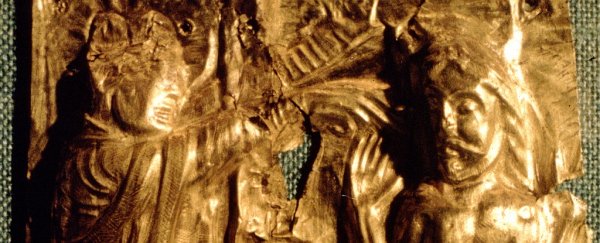An incredibly rare cache of Viking Age treasure has been unearthed on the German island of Rügen in the Baltic sea.
Discovered by a 13-year-old boy and his teacher, the find consists of necklaces, pearls, brooches, bracelets, rings and up to 600 silver coins - and some of the treasure has been linked to a famous king who lived over 1,000 years ago.
"It's the biggest trove of such coins in the southeastern Baltic region," Mecklenburg-West Pomerania state archaeology office said in a statement.
Amateur archaeologists René Schön and student Luca Malaschnitschenko - volunteers with the state archaeology office - were using metal detectors to search for treasure in January when they found what looked like a nondescript piece of aluminium.
However, when they took it to the State Office, the find was revealed to be much more - a silver coin, later identified as hailing from the Viking Age trading settlement of Hedeby.
The State Office requested the pair keep their find under wraps to allow time for excavation. That was three months ago, and now archaeologists have excavated an area covering 400 square metres (4,300 square feet), unearthing much more treasure.
Find by amateur archaeologists _ one age 13 _ leads to silver treasure trove in Germany linked to the reign of Viking king "Harald Bluetooth." https://t.co/X6VAJd7P1c
— AP Europe (@AP_Europe) April 16, 2018
The Danish king Harald Gormsson (c910-c987), known as Bluetooth for a discoloured tooth, was one of the first kings of Denmark, and is known for bringing Christianity to his country.
Bluetooth technology was named after him, for his purported networking and communication skills.
In fact, the Bluetooth logo is also derived from the 'H' and 'B' of his initials.
Towards the end of his life, Bluetooth's son Sweyn Forkbeard rebelled against his father and took the throne, while Bluetooth fled to Pomerania - northeast Germany on the Baltic sea - where he died a year or so later.
The coins found allowed the archaeologists to date the find to the time Bluetooth would have been in the area. The oldest coin, a Damascus dirham, dates to 714 CE, and the newest is a penny from 983 CE.
"We have here the rare case of a discovery that appears to corroborate historical sources," archaeologist Detlef Jantzen told The Guardian.
Other treasures linked to the king have been found in the area, notably the spectacular Hiddensee treasure, containing both Christian crosses and Thor's hammer symbols wrought in gold.
